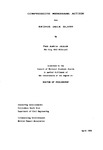COMPRESSIVE MEMBRANE ACTION in BRIDGE DECK SLABS
| dc.contributor.author | JACKSON, PAUL AUSTIN | |
| dc.contributor.other | School of Engineering, Computing and Mathematics | en_US |
| dc.date.accessioned | 2013-11-06T11:25:45Z | |
| dc.date.available | 2013-11-06T11:25:45Z | |
| dc.date.issued | 1989 | |
| dc.identifier | NOT AVAILABLE | en_US |
| dc.identifier.uri | http://hdl.handle.net/10026.1/2622 | |
| dc.description | Merged with duplicate record 10026.1/654 on 27.02.2017 by CS (TIS) | |
| dc.description.abstract |
An elastic analysis of restrained slab strips shows that membrane action enhances serviceability behaviour. However, the enhancement is not as great as for strength and serviceability is critical when membrane action is considered in design. A relatively simple form of non-linear finite element analysis is developed which is able to model bridge deck behaviour allowing for membrane action. This reduces some of the disadvantages of non-linear analysis which have prevented its use in practice. It uses line elements but, because of novel features of the elements and because it considers all six degrees of freedom at each node, it is still able to model in-plane forces reasonably realistically. It gives acceptable predictions for behaviour. The tension stiffening functions used in non-linear analysis, which are important to the prediction of restraint, are considered. Explanations are proposed for several aspects of the behaviour and a new function is developed. This gives better results than previous expressions, particularly for deflections on unloading and reloading. Tests under full HB load have been performed on two half scale bridges. These, and the analysis, show that conventional design methods for deck slab reinforcement are very conservative. They also show that the restraint required to develop membrane action is not dependent on diaphragms; it comes from under-stressed material surrounding the critical areas. Thus, over much of a bridge's span, there is transverse tension in the slab and membrane action does not significantly enhance the resistance to global moments. Both bridge models failed by a wheel punching through the slab. It is shown that these were primarily brittle bending compression failures which were strongly influenced by global behaviour. This is confirmed both by the analysis and by the higher wheel load at failure in single wheel tests. Recommendations are made for using the results in design and assessment. | en_US |
| dc.description.sponsorship | British Cement Association | en_US |
| dc.language.iso | en | en_US |
| dc.publisher | University of Plymouth | en_US |
| dc.title | COMPRESSIVE MEMBRANE ACTION in BRIDGE DECK SLABS | en_US |
| dc.type | Thesis | |
| plymouth.version | Full version: final and full version as approved by the examiners at the time of the award of your degree | en_US |
| dc.identifier.doi | http://dx.doi.org/10.24382/3902 | |
| dc.identifier.doi | http://dx.doi.org/10.24382/3902 |
Files in this item
This item appears in the following Collection(s)
-
01 Research Theses Main Collection
Research Theses Main


